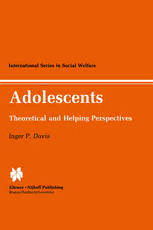
Adolescents: Theoretical and Helping Perspectives PDF
Preview Adolescents: Theoretical and Helping Perspectives
ADOLESCENTS: Theoretical and Helping Perspectives International Series in Social Welfare Series Editor: William J. Reid State University of New York at Albany Advisory Editorial Board: Werner W. Boehm Rutgers, The State University New Brunswick, N.J., USA Naomi Golan University of Haifa ISRAEL Tilda Goldberg Policy Studies Institute London, England, UK Francis J. Turner Laurentian University Ontario, CANADA Previously Published Books in the Series: Crane, J.A., The Evaluation of Social Policies, 1982 Schuerman, J.R., Multivariate Analysis in the Human Services, 1983. Hollingsworth, J.R., and Hanneman, R., Centralization and Power in Social Service Delivery Systems, 1983 Stein, T.J. and Rzepnlcki, T., Decision Making in Child Welfare Services, 1984 Clarke, R. and Hope, T., Coping with Burglary, 1984 Sherman, E., Working with Older Persons, 1984 ADOLESCENTS Theoretical and Helping Perspectives Inger P. Davis San Diego State University College of Human Services School of Social Work Kluwer·NIJhoff Publishing a member of the Kluwer Academic Publishers Group Boston/Dordrecht/Lancaster Distributors for North America: KLUWER ACADEMIC PUBLISHERS 190 Old Derby Street H Ingham, Massachusetts 02043, U.S.A. Distributors outside North America: KLUWER ACADEMIC PUBLISHERS GROUP Distribution Centre P.O. Box 322 3300 AH Dordrecht, THE NETHERLANDS Library 01 Congress Cataloging In Publication Data Davis, Inger P. Adolescents: theoretical and helping perspectives. (International series In social welfare) Bibliography: p. Includes Index. 1. Youth - United States. 2. Adolescent psychology. 3. Interpersonal relations. 4. Youth - Services lor - United States. I. Title. II. Series. HQ796.029 1985 305.2'35 84·20175 ISBN-13: 978-94-010-8706-3 e-ISBN-13: 978-94-009-4984-3 001:10.1007/978-94-009-4984-3 Copyright © 1985 by Kluwer-Nljhoff Publishing. Softcover reprint of the hardcover 1s t edition 1985 No part of this book may be reproduced In any form by print, photoprlnt, microfilm, or any other means without written permission 01 the publisher. Contents Acknowledgments ix 1 Introduction 1 A Few Statistics on the Adolescent Population 2 Trends in the Research Literature on Adolescence 3 General Purpose of Book and Sources of Materials Used 5 Plan for the Book 6 I Adolescent Development and Psychosocial Tasks 9 2 History, Facts, and Theories 11 A Few Historical Pointers 12 Physical Growth 16 Cognitive Development 20 Twentieth Century Adolescent Developmental Theories 25 Summary 40 3 Developmental Tasks of Adolescence In Relation to the Family 43 The Havighurst Formulation of Developmental Tasks 43 Family-Adolescent Relations 46 Summary 73 v vi CONTENTS 4 Developmental Tasks of Adolescence: Peers, Identity Achievement, and Some Gender and Cultural Differences 77 Adolescent Peer Relations 78 Identity Achievement 86 Gender Differences in Adolescent Development 95 Social Class and Cultural Differences in Adolescent Development 100 Summary 105 II Services and Interpersonal Interventions Assisting Troubled Adolescents and Their Families 109 5 Educational and Supportive Services for Adolescents LIving with Their Families 111 Educational and Supportive Services 113 Schools 114 Medico·Social Services 120 Community Mental Health Care 123 Other Community Based Public and Private Services 128 Adolescence and the Law 130 6 Out·of·Home Care for Adolescents 135 Adolescents in Foster Family Care 138 Adolescents in Community Group Residences 145 Adolescents in Institutions 146 Parental Involvement 153 Adolescents on the Adoption Scene 155 7 Interpersonal Interventions 167 Family versus an Individualistic Perspective 168 Empirical Foundations 170 Assessment 172 Interventive Modalities 175 8 Interventions with Specific Groups of Adolescents 193 Divorce and Stepfamily Counseling 193 Adolescents in Out·of·Home Care 197 Dynamics and Treatment of Runaway Youth 203 A ClOSing Word 214 CONTENTS vii Additional Readings on Interventions with Physically and Sexually AbuHd AdoIescants and Their Famill .. 217 Bibliography 219 Name Index 253 Subject Index 261 Acknowledgments Appreciation is expressed to William J. Reid, editor of the International Series in Social Welfare for his encouragement and unintrusive and con structive suggestions. The Office of Human Development Services, Depart ment of Health and Human Services provided financial support in the early stages of this project (Child Welfare Teaching Grant, 1979 #8-1092377, 1980 #9-1092376, and 1982 #1-1092377). Elsie Herman, Hope Logan, and Lorraine Newbrough, former colleagues of mine at the School of Social Work, San Diego State University, participated directly in one or more of these grant supported child welfare projects. Their contributions are gratefully acknowledged. Several graduate seminars made use of early versions of this book, which has been enriched by the students' ideas and practice experiences. Graduate research assistants helped in several phases of this project: Laura Haslam, Sandra A. Parsons, Linda Peterson, and Diana S. Smith deserve special mention. I am grateful for contributions from many other persons, social service agency representatives, practitioners from various disciplines, and, not least, for what I have learned directly from troubled adolescents and their families. ix ADOLESCENTS: Theoretical and Helping Perspectives 1 INTRODUCTION This book deals with ways of helping families cope with the difficulty of rais ing adolescents. Professional social workers - along with other human ser vice professionals - encounter these families in numerous settings: child welfare and family service agencies, hospitals, schools, community mental health clinics, residential treatment centers, juvenile halls and detention centers, recreational and vocational training organizations, and many others. While families from all walks of life may be found in these settings, families who have suffered the additional stresses of poverty, discrimination, and the consequences of physical and mental illness are commonly overrepresented. Even under the best of circumstances, the adolescent years often put the strongest family structures to the test - sometimes to the breaking point. A recent national study of over one thousand average, middle-income, two parent families reviewed the strengths, stresses, and satisfactions of the family life cycle (Olson and McCubbin 1983). As many would expect, families with adolescents were found to experience more stress and lower levels of family adaptability, cohesion, and marital and family satisfaction than any other developmental stage. The families with adolescents who fared best were those with such marital resources as good communication and conflict resolution skills, satisfying sexual relations, and good parent-adolescent communication. 1
